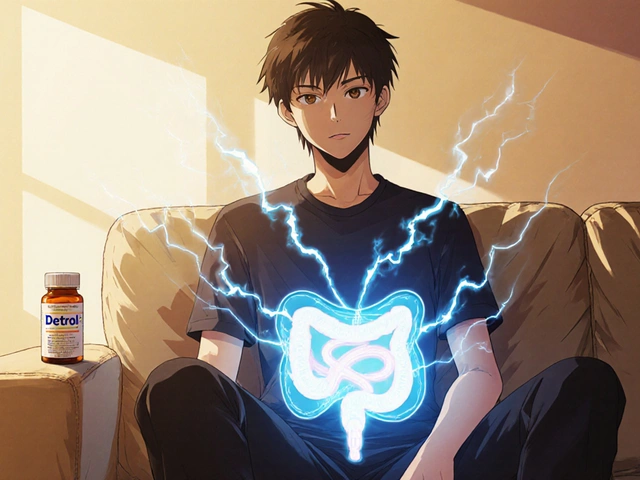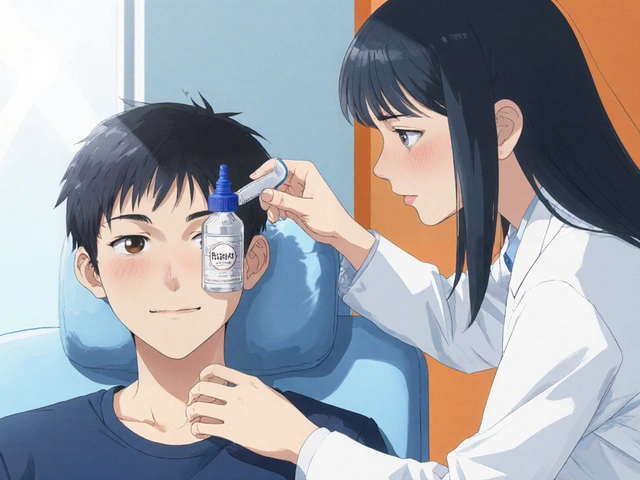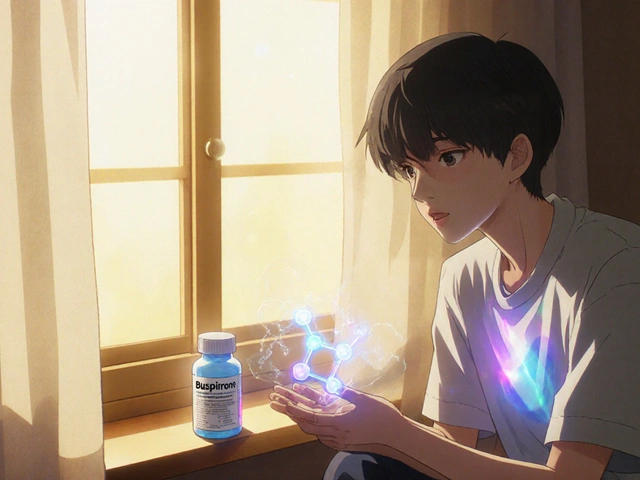Overactive Bladder Treatment Selector
Answer a few questions about your needs and concerns. The tool will help you evaluate which treatment options might be most suitable for you based on the article content.
Remember: Your doctor will need to evaluate your specific situation before making any changes to your treatment plan.
- Don't stop or change your current medication without consulting your doctor first
- Some treatments require a trial period to see if they work
- Combining treatment approaches often gives the best results
- Behavioral therapies like bladder training and pelvic floor exercises can significantly improve symptoms
If you’re taking Detrol (tolterodine) for overactive bladder and wondering if there’s a better option, you’re not alone. Many people switch medications because of side effects, cost, or lack of results. Detrol works by relaxing the bladder muscle to reduce sudden urges and frequent urination. But it’s not the only choice. In fact, several alternatives exist - some work faster, others have fewer dry mouth or constipation issues, and a few don’t even work the same way at all.
How Detrol (Tolterodine) Actually Works
Detrol belongs to a class of drugs called anticholinergics. These block a chemical in your body called acetylcholine, which tells your bladder to contract. When that signal is weakened, your bladder holds more urine and you feel fewer urgent urges. Most people start seeing results in 1-2 weeks. A typical dose is 2 mg twice daily, though extended-release versions (Detrol LA) let you take it once a day.
But here’s the catch: anticholinergics don’t just affect your bladder. They also hit your salivary glands, eyes, gut, and brain. That’s why common side effects include dry mouth (affects nearly 40% of users), constipation, blurred vision, and dizziness. For older adults, these can be risky - studies show a higher chance of confusion and falls with long-term use.
Alternative 1: Oxybutynin (Ditropan, Gelnique)
Oxybutynin is one of the oldest bladder medications and works just like Detrol - blocking acetylcholine. But it’s stronger, and that means more side effects. Dry mouth hits up to 60% of users. Some people can’t tolerate it at all.
There’s a twist, though: oxybutynin comes in patches (Gelnique) and skin gels. These deliver the drug through your skin, so less of it enters your bloodstream. That cuts down on side effects. A 2023 study in the Journal of Urology found that 58% of patients switching from oral Detrol to Gelnique reported fewer dry mouth issues and better adherence.
If you’re struggling with daily pills and hate dry mouth, the patch or gel might be worth trying. But don’t expect miracles - it still causes drowsiness and can make you feel foggy.
Alternative 2: Mirabegron (Myrbetriq)
Mirabegron is completely different. Instead of blocking signals, it activates beta-3 receptors in your bladder muscle, helping it relax and hold more urine. Think of it like giving your bladder a gentle nudge instead of jamming a brake.
Because it doesn’t touch acetylcholine, it avoids the classic anticholinergic side effects. Dry mouth? Rare. Constipation? Uncommon. Cognitive issues? Almost never. That’s why it’s often recommended for older adults or people on multiple medications.
But it’s not perfect. Mirabegron can raise blood pressure. If you have uncontrolled hypertension, your doctor will monitor you closely. It’s also more expensive than Detrol unless you have good insurance. Still, for many, the trade-off is worth it - fewer side effects mean fewer missed doses and better long-term control.
Alternative 3: Solifenacin (Vesicare)
Solifenacin is another anticholinergic, but it’s more selective for the bladder. That means it’s slightly less likely to mess with your saliva or gut than Detrol or oxybutynin. Studies show about 30% of users report dry mouth - better than oxybutynin, similar to Detrol.
It’s taken once daily as an extended-release tablet. Many patients find it easier to stick with than Detrol because of the once-daily dosing. Some report better symptom control, especially for nighttime urges.
But here’s something important: solifenacin can still cause constipation and blurred vision. And like all anticholinergics, it’s not ideal if you have glaucoma or severe liver disease. Still, if Detrol isn’t working well enough, solifenacin is a solid next step.
Alternative 4: Tolterodine Extended-Release (Detrol LA)
Wait - isn’t that the same as Detrol? Technically, yes. But Detrol LA is the long-acting version. It releases tolterodine slowly over 24 hours, so you only take one pill a day. Many people switch from immediate-release Detrol to Detrol LA simply to cut down from two pills to one.
Side effects are similar, but some report less of a "peak and crash" feeling - meaning fewer sudden dizziness episodes. If you’re already on Detrol and just tired of taking it twice a day, Detrol LA might be all you need.
Alternative 5: OnabotulinumtoxinA (Botox) Injections
This isn’t a pill - it’s a shot. Botox is injected directly into the bladder wall during a minor procedure. It temporarily paralyzes the muscle, reducing contractions. Results last 6-12 months.
It’s usually reserved for people who’ve tried at least two oral meds without success. In clinical trials, about 60-70% of patients saw a 50% or greater drop in urinary urgency and incontinence episodes.
The downside? You might need to self-catheterize temporarily after the injection because your bladder can become too relaxed. There’s also a small risk of urinary tract infections. But for those who’ve tried everything else, Botox can be life-changing.
Alternative 6: Behavioral Therapy (No Pills Needed)
Before you reach for another prescription, consider this: behavioral therapy works as well as - or better than - many drugs. A 2024 meta-analysis in the New England Journal of Medicine showed that pelvic floor exercises, bladder training, and fluid management reduced incontinence episodes by 65% on average - better than most medications.
Bladder training means slowly increasing the time between bathroom visits. Pelvic floor exercises (Kegels) strengthen the muscles that hold urine in. Keeping a diary of what you drink and when you go helps identify triggers.
These aren’t quick fixes. It takes 8-12 weeks to see results. But they’re free, safe, and have zero side effects. Many doctors now recommend combining them with medication - not replacing it.

What’s the Best Choice for You?
There’s no single "best" drug. The right one depends on your body, your lifestyle, and what side effects you can live with.
If you’re older and on other meds, mirabegron is often the safest bet. If dry mouth is your biggest problem, try the oxybutynin patch. If you want fewer pills, go for Detrol LA or solifenacin. If pills haven’t helped at all, talk to your doctor about Botox.
And don’t underestimate behavioral therapy. Even if you take a pill, adding bladder training can double your results. Many patients who combine both stop needing medication entirely within a year.
Cost and Insurance: What You Should Know
Detrol (generic tolterodine) is cheap - often under $10 a month with insurance. Solifenacin and mirabegron are pricier, sometimes $50-$100 a month unless you have coverage. Botox can cost $800-$1,200 per treatment, but many insurers cover it after other options fail.
Always ask your pharmacist about patient assistance programs. Manufacturers of mirabegron and solifenacin offer coupons that cut the price in half. Generic tolterodine is almost always the most affordable.
When to Stop and See Your Doctor
Switching meds is fine - but don’t do it alone. If you’re having:
- Severe constipation or trouble urinating
- Confusion, memory issues, or dizziness that affects daily life
- Signs of a urinary tract infection (burning, fever, cloudy urine)
- No improvement after 6-8 weeks on a new drug
Call your doctor. You might need a different dose, a different drug, or further testing. Sometimes what looks like a medication problem is actually something else - like a bladder infection, nerve issue, or even sleep apnea.
Final Thought: It’s About Control, Not Just Pills
Overactive bladder isn’t just about wetting yourself. It’s about losing confidence, skipping social events, or sleeping alone because you’re afraid of the bathroom. The goal isn’t just to find the best pill - it’s to get your life back.
Detrol works for many. But it’s not the only path. Whether it’s a patch, a shot, a new pill, or learning to retrain your bladder - you have options. Talk to your doctor. Try one thing at a time. And don’t give up. Better control is possible.
Is Detrol the same as tolterodine?
Yes. Detrol is the brand name for the drug tolterodine. Generic tolterodine works the same way and is usually much cheaper. The extended-release version is called Detrol LA.
Can I switch from Detrol to mirabegron safely?
Yes, but not suddenly. Your doctor will usually have you taper off Detrol over a week while starting mirabegron. This avoids a sudden return of bladder symptoms. Mirabegron is often preferred for older adults or those with memory concerns because it doesn’t cause brain fog like anticholinergics do.
What’s the most common side effect of Detrol?
Dry mouth is the most common side effect, affecting about 40% of users. Constipation and blurred vision are also frequent. These happen because Detrol affects acetylcholine receptors throughout the body, not just in the bladder.
Are there natural alternatives to Detrol?
There’s no herbal supplement proven to replace Detrol. But behavioral methods like pelvic floor exercises, bladder training, and reducing caffeine/alcohol can significantly reduce symptoms - sometimes as effectively as medication. These are safe, free, and recommended as a first step by urologists.
How long does it take for alternatives to work?
Pills like mirabegron, solifenacin, or Detrol LA usually take 1-2 weeks to show results. Botox injections take 2-4 weeks to fully work. Behavioral therapy takes the longest - 8-12 weeks - but the benefits last longer and don’t require ongoing medication.
Can I take Detrol with other medications?
Detrol can interact with many common drugs, including some antidepressants, antifungals, and heart medications. These can increase tolterodine levels in your blood and raise the risk of side effects. Always tell your doctor and pharmacist about everything you’re taking - even over-the-counter pills and supplements.






Write a comment
Your email address will be restricted to us